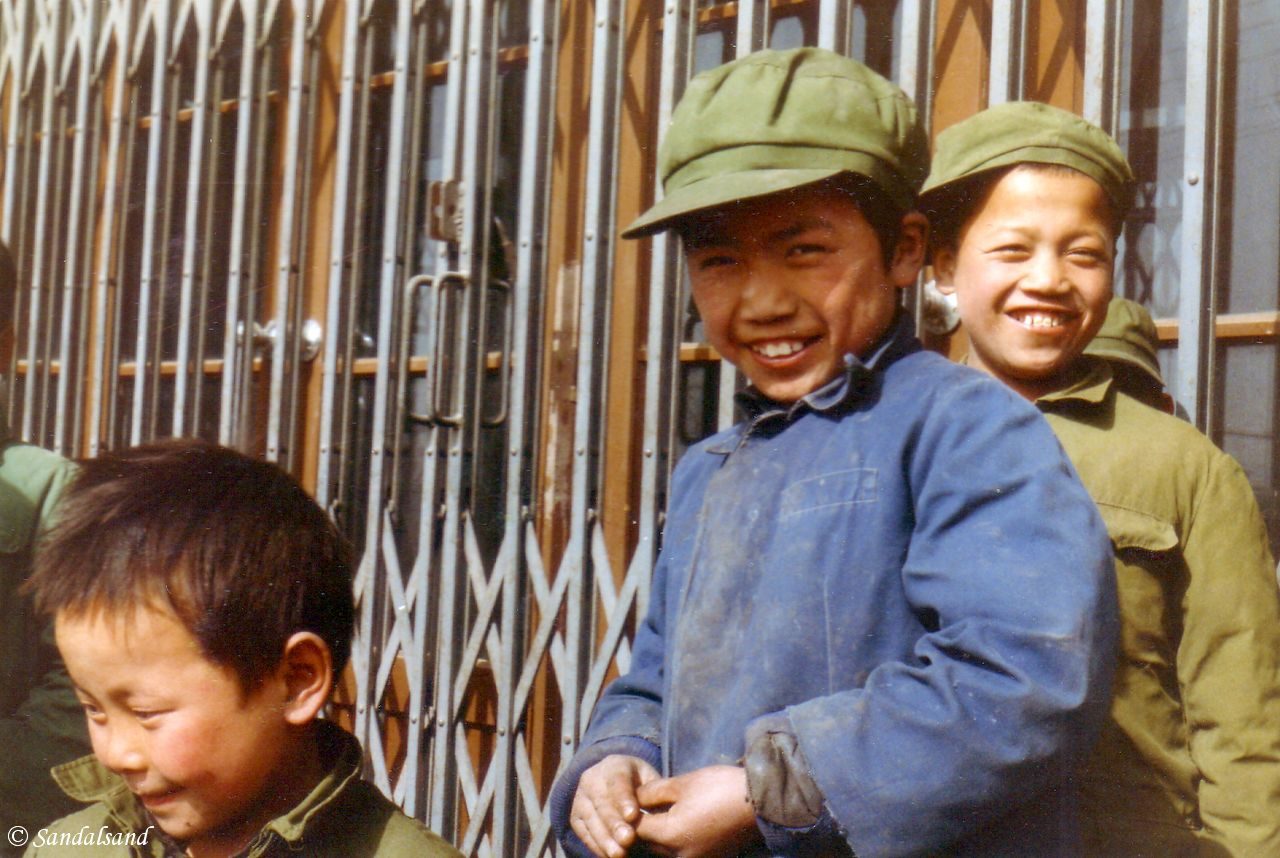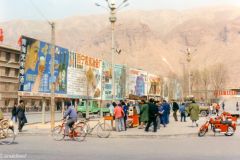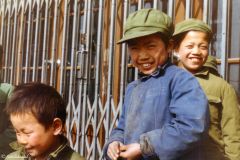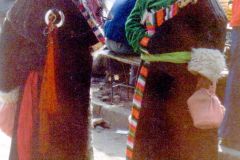From Lhasa I managed to get a bus ticket out of Tibet, to Golmud. At that time in 1985 in was forbidden for foreigners to enter this city. Read about it, and the onward journey.
This article is part of a diary based travelogue from a six month journey in 1985 to several countries in East and South East Asia: Japan, Taiwan, China, Philippines, Singapore, Malaysia and Thailand.
Tuesday 5.3 and Wednesday 6.3.1985, Lhasa – Golmud
A rough bus ride
The bus arrived in Golmud 33 hours after departure. The first day was grand, seen from the eyes of a nature lover. We climbed higher and higher and could along the way see snow-capped mountains and Tibetans in full “armour” – on horse or on foot – herding their flocks of sheep and goats and in particular all their yaks. The latter were, it seemed, somewhat smaller than the bison and musk ox, their nearest of kin.
Some of the Tibetans we could actually see lying stretched out on the ground praying in the same way we had seen them in Lhasa.
Everywhere there was an endless mountain plateau with only a few tufts of grass on. Very sparse.
The bus we took was exceptional, a very old and well used one as such. Take the old, worn-out “madla”-buses, cut off some of their length and one gets some of the quality (or lack of it) we travelled in. One will have to look long for such a wreck with so weak shock absorbers on a combination of bumpy asphalt and gravel.
Was it all that bad?
But nonetheless; the trip was not as incredibly terrible after all, even though my patience was put to very hard tests on a number of occasions. Not to talk of the endurance and sleeplessness after a long night of severe cold and no heating on board. And the bus broke down every so often.
Apart from me there was Nille and Karen, and a Swiss. He was a man of few words, low-key and confused. He had lost his luggage, or more correctly, had it stolen right before we left the bus station in Lhasa. In addition there were some Chinese. Two Tibetans sat on the bus too far and were thrown off at a truck-stop in the middle of the night.
We stopped for half an hour in the middle of nowhere and ate some soup and dumplings. That was the only long stop on the trip. Apart from that we brought our own food.
Arriving in Golmud
With a light brain concussion after 33 hours with continuous hopping in the seat knocking the head in the roof, we arrived in Golmud.
We had to walk pretty far to the hotel and were stopped by the Public Security Bureau (PSB) on the way. They proved however utterly kind and charming, quite surprisingly considering Golmud’s status as a closed city. They politely commanded us to take the train on to Xining the following day.
- HOTEL of a name I can’t recollect, and equally difficult to explain the way. But if the bus from Lhasa stops at the same place every time then 1) walk straight ahead to the first large junction, with a large case in the middle, 200 m; 2) turn right and continue for 300 m; 3) turn slightly left. After 100 metres the PBS is on the left hand side; 4) Turn right 150 m later and continue 300 m (these are all approximate distances). The hotel is easy to see on the left hand side. Price: 5Y. With my student card we quarrelled to pay in Renmimbi. The shower was extra, but it was lovely. 4-bed room.
Thursday 7.3.1985, Golmud – Xining
We took a morning train to Xining, straight to the east. Our arrival was 27 hours later, quite exciting hours too. We had from the outset only hard-seats, for a Chinese price due to my student card. It was our wish to change to hard-sleepers on the train.
The girls went to buy while Philippe from Switzerland and me minded the luggage and the seats we had fought for. The case is that we had been pressed to run across the platform with a lot of Chinese, and climb through windows and doorways to get them. Before that we had played innocent Western tourists and sneaked in line to be the first out on the platform.
For some reason we received soft sleepers, something that annoyed us at first. Nille and Karen were so annoyed that they lost their temper and yelled at the conductor in Danish (!). (Maybe just as well, as nobody spoke English anyway.)
The soft sleepers are expensive, so I figured they wanted to keep the hard sleepers to themselves (the Chinese) and give the soft ones for tourists who evidently could afford such a luxury. I soon realised that we were not getting anywhere so I calmed down the girls and tried to make them concentrated on the positive aspects of our present condition.
And it surely was interesting to travel first class in China just once. We had the restaurant car to ourselves and with that came excellent meals for not much more than a dollar. (The train cost us 50Y each. 1 USD = 2.8 Yuan)
Letter to my family
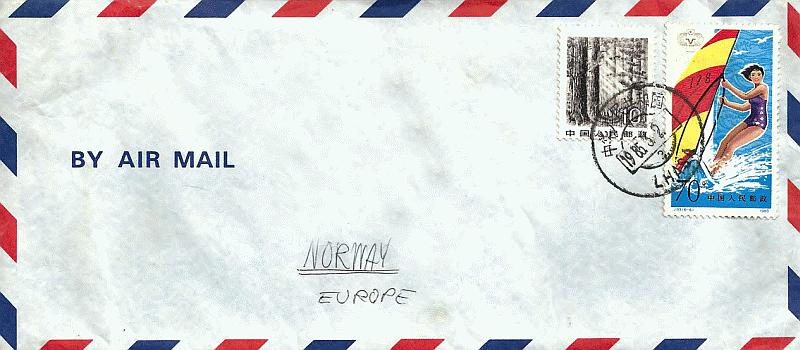
On the train a place in the desert in north-western China, 7. March 1985
Hello all!
I’m sitting in bed on the train, a couple of hours after departing on yet a journey of a day and night, or so. That’s how it is with travels in China; one almost asks how many days it takes from one place to another.
But it is not really as boring as one would imagine, as long as you have something to do. I’m in a compartment with two Danish “piger” (girls) and a Swiss guy, and I’ve travelled with them for two-three days now. They have been very adventurous days as well. Read on, read on….
As I indicated already in the previous letter you received from Lhasa in Tibet, my ten days there were very pleasant and exciting. In many ways it was like entering an “uncivilised” and in any case distant past. The Chinese (and Western tourists) have not yet destroyed the original Tibetan. Even though the Dalai Lama fled in 1959 and there are only 9-10 remaining monasteries out of 1600, the Chinese have not crushed the strong religious sentiments of the people.
Everywhere you see them mutter prayers, turn the prayer wheels or count their prayer beads, while others repeatedly lie down flat on the ground. There were so many of them in the temples and monasteries I visited.
.
In addition I relaxed on the porch outside the hotel rooms in the strong sunlight, and actually got a nice tan.
The two I arrived here together with, the Canadian student in China and the red-haired Irishman, went back before me. But don’t you believe I was alone for that reason, because into my room moved a Swedish girl, in addition to two Swedish boys in another room and four Danes in the room next door; it really became a Scandinavian venue.
We went round and ate Yak-meat, drank Yak-tea, had Yak-butter on the bread. The Yak is the Tibetan equivalent to the Red Indian’s bison – it is used for everything.
But I couldn’t stay in Tibet forever. (My original plans would have led me far south in the Philippines by now, and I figure on staying in China another couple of weeks, on top of the first three.) I therefore booked the cheapest way out, on a bus north to Golmud. The flight ticket was a hundred dollars too expensive.
As I mentioned in my previous letter, Golmud is a forbidden city and the same goes for the overland trip from Tibet. The reason is probably that this province is China’s answer to the Soviet Siberia when it comes to concentration camps. We got in any case out of Tibet and the police in Golmud was very polite. (And of course they assisted us in finding out when the first train out was leaving.)
.
Like I said the bus trip was interesting, but extremely demanding. We sat there almost without a break for 33 hours on the worst rickety bus imaginable. Half the way was on a road surface of crushed stone. The rest of the way was on asphalt reminding of a roller-coaster in ultra-miniature. The result is that I’m probably sitting here with a minor brain concussion and “loose” inner organs. So it feels.
But apart from that: The road climbed to an altitude of 5000 metres, crossed endless plains where we passed Tibetans on horse or on foot with their sheep and yak herds. Their houses were made of chalked brick and turf, if anything at all.
Towards us came endless caravans of trucks on the way to Lhasa; they are almost the only means of transporting supplies into the province. The second day, after a miserable night, we came down to and into the desert. Not the usual sand desert kind, but one interspersed with rocks and in any case incredibly dry.
.
Golmud greeted us with dust, dust, dust, and we left already the next morning (today). It is an incredibly boring town where it is unbelievable that anyone wants to live. The same with the other towns we have passed today.
We have had some lovely meals here on the train, in the dining car. We are actually travelling first class. It is really a mistake, but we don’t regret that now. It is an interesting experience. We are heading east to Xian. I am going to see the terracotta soldiers and then continue to Peking to read your month old letter, and so on.
Until then, hugs from
Me
Next letter: Beijing
Friday 8.3.1985, Xining
We arrived in Xining early in the afternoon and bought after a couple of hours waiting in line hard-seat tickets to Xian. We couldn’t afford more, even though the trip would take 24 hours. (Fare: 15,8Y)
On the street market in front of the station they had some very good white bread with hard crust. We bought some of it as provisions. On the market we also noticed some people dressed as Tibetans, but with faces almost like the Han-Chinese.
This time we got onto our train before the crowds of locals came running. The reason was that we made use of the exit dedicated to travellers with small children.
The night on a hard seat was a mixed experience, but we did actually sleep for a few hours. It is incredibly jammed in these trains!
Read more
The introduction to this journey to East and South East Asia.
Previous chapter: 11 days on top of the world, in Tibet, few months after its opening up for individual travellers
Next chapter: Xian: Terracotta soldiers and a long way to go in hospitality

